Is Sustainability Compatible with Profitability? An Empirical Analysis on Family Farming Activity
Abstract
:1. Introduction
2. Empirical Analysis
2.1. Case Study
2.2. Data and Methods
3. Estimations and Results
4. Discussion and Conclusions
Acknowledgments
Author Contributions
Conflicts of Interest
Appendix A
| 1 | 2 | 3 | 4 | 5 | 6 | 7 | 8 | 9 | 10 | 11 | 12 | 13 | 14 | 15 | |
|---|---|---|---|---|---|---|---|---|---|---|---|---|---|---|---|
| 1. PROFIT | 1 | - | - | - | - | - | - | - | - | - | - | - | - | - | - |
| 2. DM | −0.32 | 1 | - | - | - | - | - | - | - | - | - | - | - | - | - |
| 3. FA | −0.11 | 0.29 | 1 | - | - | - | - | - | - | - | - | - | - | - | - |
| 4. FED | 0.19 | −0.03 | −0.11 | 1 | - | - | - | - | - | - | - | - | - | ||
| 5. GEN | 0.07 | −0.08 | −0.31 | 0.04 | 1 | - | - | - | - | - | - | -- | - | ||
| 6. SC | 0.40 | 0.21 | −0.02 | 0.21 | 0.06 | 1 | - | - | - | - | - | - | |||
| 7. SP | −0.22 | 0.15 | −0.05 | −0.14 | 0.21 | 0.14 | 1 | - | - | - | - | - | - | - | - |
| 8. COP | 0.02 | −0.02 | 0.29 | −0.17 | 0.02 | −0.18 | 0.01 | 1 | - | - | - | - | - | - | - |
| 9. OPM | 0.36 | 0.09 | 0.15 | 0.08 | 0.19 | 0.12 | −0.27 | 0.03 | 1 | - | - | - | - | - | - |
| 10. EC | 0.16 | 0.02 | −0.11 | −0.01 | 0.10 | 0.00 | −0.06 | 0.04 | 0.15 | 1 | - | - | - | - | - |
| 11. DL | 0.09 | 0.05 | 0.27 | −0.19 | −0.04 | −0.11 | 0.01 | 0.09 | −0.05 | −0.10 | 1 | - | - | - | - |
| 12. SEC | 0.01 | 0.04 | 0.05 | 0.00 | 0.04 | 0.05 | −0.05 | 0.28 | 0.21 | 0.14 | 0.34 | 1 | - | - | - |
| 13. EII | 0.19 | 0.08 | 0.12 | 0.05 | 0.15 | 0.21 | −0.03 | 0.15 | 0.25 | 0.15 | 0.10 | 0.38 | 1 | - | - |
| 14. RD | 0.28 | 0.06 | 0.04 | −0.06 | 0.14 | 0.11 | 0.07 | 0.18 | 0.29 | −0.07 | 0.14 | 0.17 | 0.25 | 1 | - |
| 15. LI | −0.27 | −0.10 | −0.25 | −0.09 | −0.20 | −0.40 | −0.11 | 0.11 | −0.14 | 0.22 | −0.04 | 0.14 | −0.02 | −0.10 | 1 |
Appendix B. Diagnostic Plots for the Estimated Model
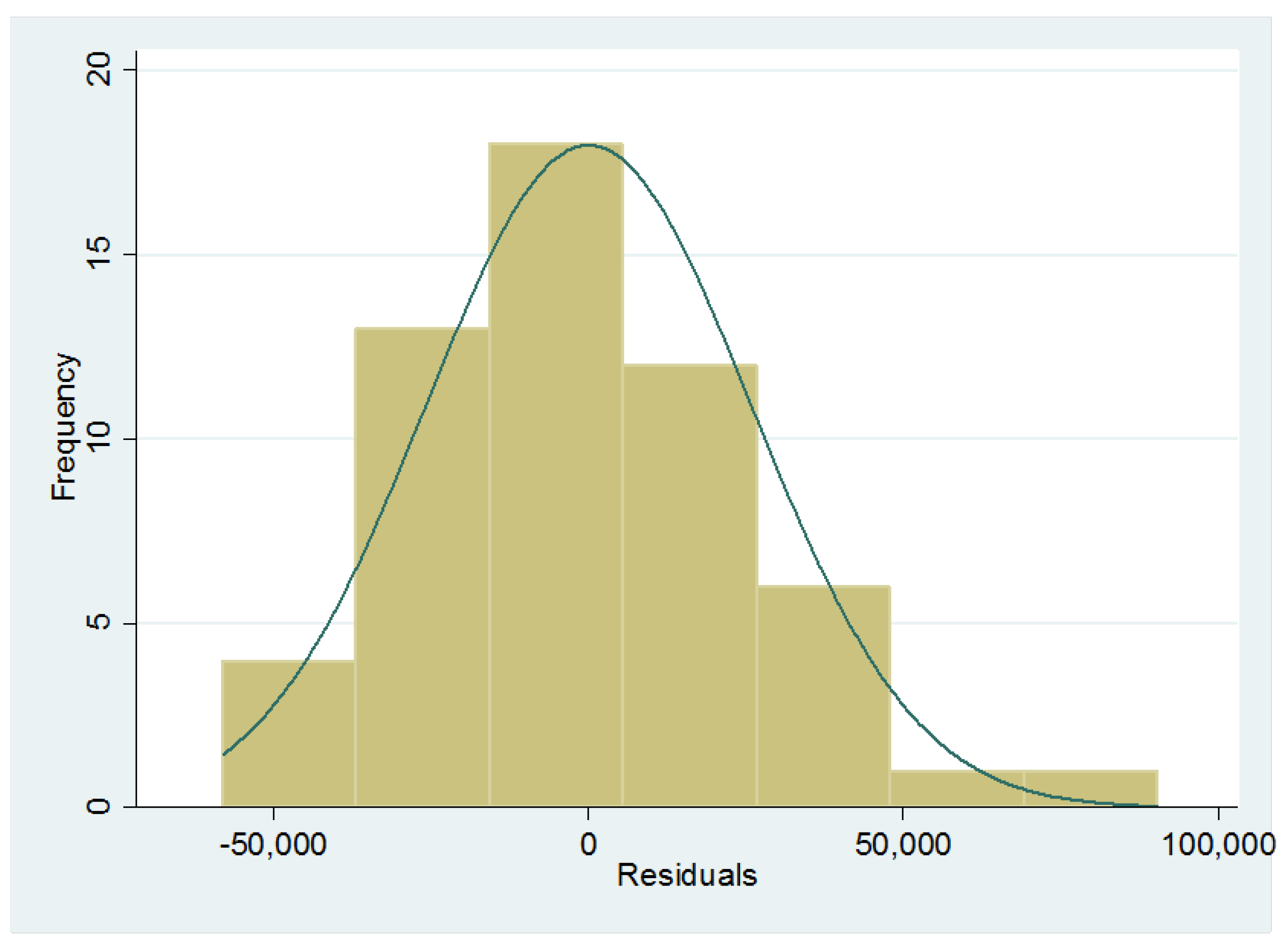
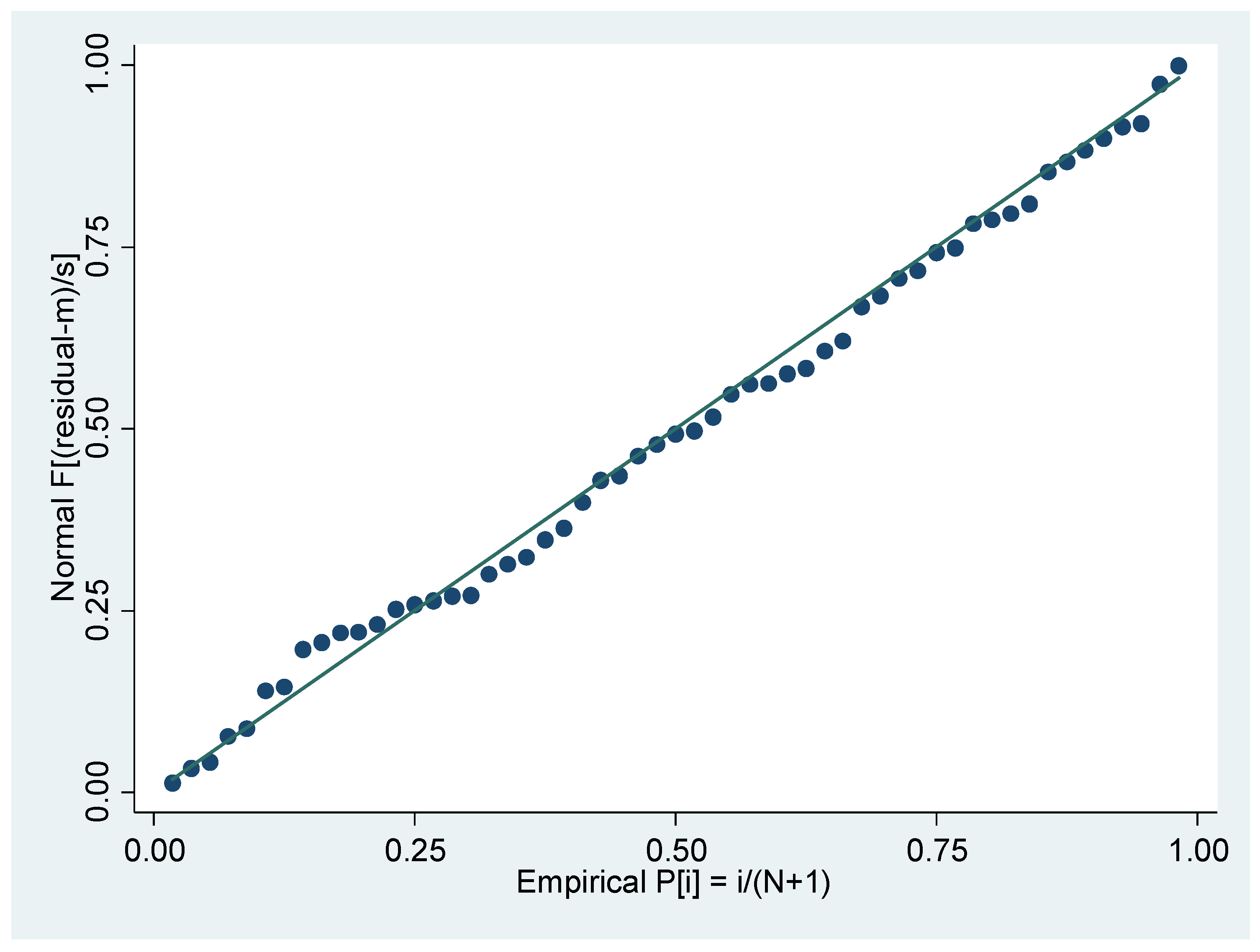
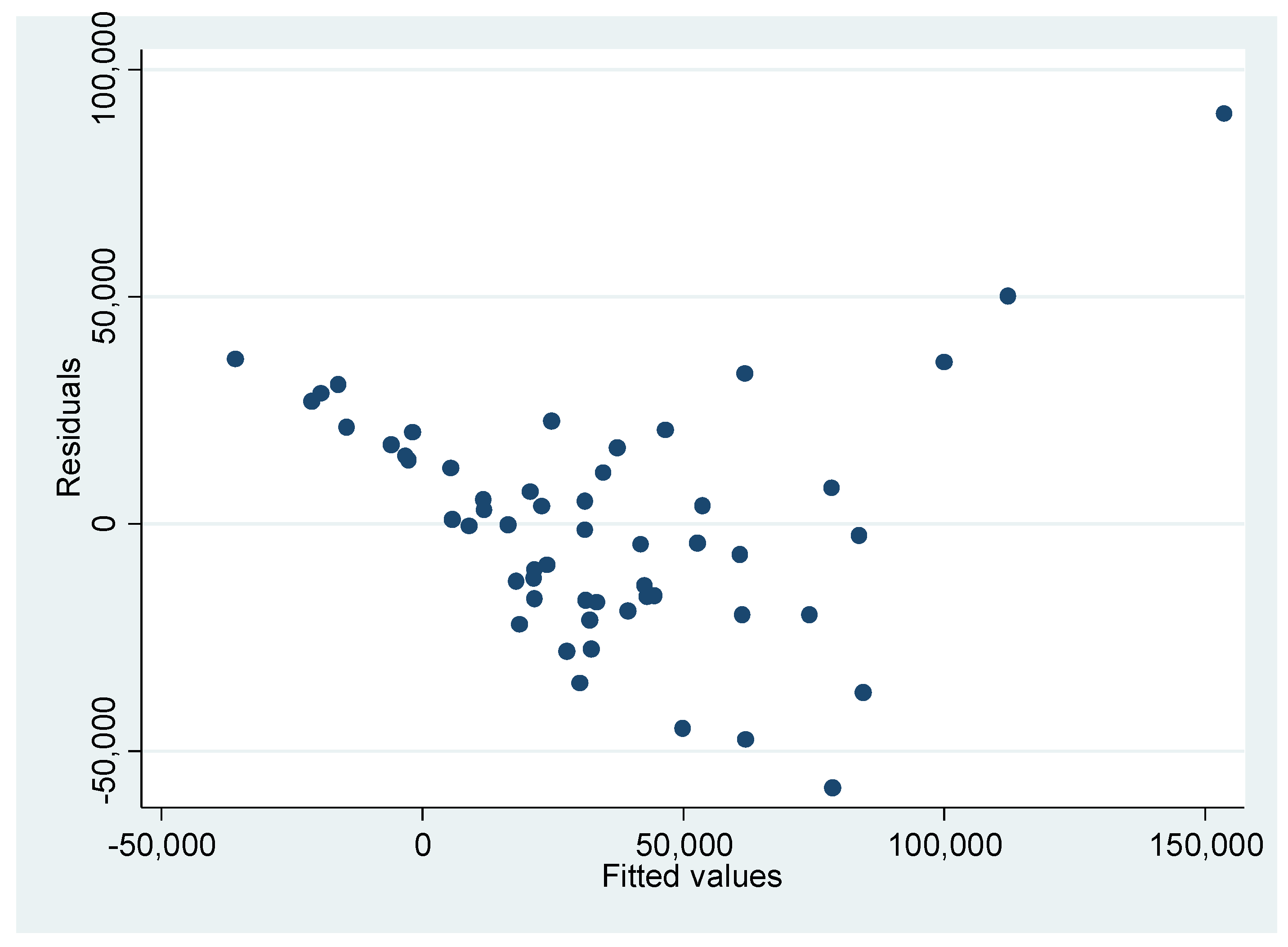
References
- Ikerd, J. The Economics of Sustainable Farming. In Proceedings of the 19th Annual Grazing Conference, Wisconsin Dells, WI, USA, 2011; Grazing, Grass Works Inc.: Wisconsin Dells, WI, USA, 2011. Available online: http://web.missouri.edu/ikerdj/papers/Wisconsin%20Grazing-%20Eco%20Sus%20Ag.htm (accessed on 28 February 2016). [Google Scholar]
- Mölders, T. Multifunctional Agricultural Policies: Pathways towards sustainable rural development? Int. J. Soc. Agric. Food 2013, 21, 97–114. [Google Scholar]
- Lehtonen, M. The environmental-social interface of sustainable development: Capabilities, social capital, institutions. Ecol. Econ. 2004, 49, 199–214. [Google Scholar] [CrossRef]
- Psarikidou, K.; Szerszynski, B. Growing the social: Alternative agrofood networks and social sustainability in the urban ethical foodscape. Sci. Pract. Policy Sustain. 2012, 8, 30–49. [Google Scholar]
- Mouysset, L.; Doyen, L.; Jiguet, F. From population viability analysis to coviability of farmland biodiversity and agriculture. Conserv. Biol. 2013, 28, 187–201. [Google Scholar] [CrossRef] [PubMed]
- Martens, J.T.; Entz, M.; Wonneck, M. Ecological Farming Systems on the Canadian Prairies. A Path to Profitability, Sustainability and Resilience; Science and Technology Branch of Agriculture and Agri-Food Canada; University of Manitoba: Winnipeg, MB, Canada, 2013. [Google Scholar]
- Porter, M.E.; van der Linde, C. Green and competitive: Ending the stalemate. Harv. Bus. Rev. 1995, 73, 120–134. [Google Scholar]
- Orlitzky, M.; Schmidt, F.L.; Rynes, S.L. Corporate social and financial performance. Organ. Stud. 2003, 24, 403–433. [Google Scholar] [CrossRef]
- Carpentier, C.L.; Ervin, D.E. Business Approaches to Agri-Environmental Management: Incentives, Constraints and Policy Issues; Organization for Economic Cooperation and Development (OECD): Paris, France, 2002. [Google Scholar]
- Brouwer, F.; Baldock, D.; Carpentier, C.L.; Dwyer, J.; Ervin, D.E.; Fox, G.; Meister, A.; Stringer, R. Comparison of Environmental and Health-Related Standards Influencing the Relative Competitiveness of European Union Agriculture vis-a-vis Main Competitors in the World Market; European Commission: Bruxels, Belgium, 2000. [Google Scholar]
- Danso, G.; Drechsel, P.; Wiafe-Antwi, T.; Gyiele, L. Income of farming systems around Kumasi, Ghana. Urban Agric. Mag. 2002, 7, 5–6. [Google Scholar]
- O’Reagain, P.O.; Bushell, J. Sustainable and profitable grazing management in a highly variable environment-evidence and insights from a long term grazing trial in Northern Australia. In Multifunctional Grasslands in a Changing World, Proceedings of the XXI International Grassland Congress and VIII International Rangeland Congress, Hohhot, China, 29 June–5 July 2008; Guangdong People’s Publishing House: Hohhot, China, 2008; Volume 2, pp. 14–19. [Google Scholar]
- Galdeano-Gómez, E. Does an endogenous relationship exist between environmental and economic performance? A resource-based view on the horticultural sector. Environ. Resour. Econ. 2008, 40, 73–89. [Google Scholar] [CrossRef]
- Darnhofer, I.; Bellon, S.; Dedieu, B.; Milestad, R. Adaptiveness to enhance the sustainability of farming systems. A review. Agron. Sustain. Dev. 2010, 30, 545–555. [Google Scholar] [CrossRef]
- Ikerd, J. Family Farms: Our Promise for a Sustainable Future. In Proceedings of the Pennsylvania Farmers Union Annual Convention, Dixon University, Harrisburg, PA, USA, 7 December 2013; Available online: http://web.missouri.edu/ikerdj/papers/Pennsylvania%20Farmers%20Union-%20Family%20Farms.htm (accessed on 28 February 2016).
- Calus, M.; Van Huylenbroeck, G. The persistence of family farming: A review of explanatory socio-economic and historical factors. J. Fam. Stud. 2010, 41, 639–660. [Google Scholar]
- Bosc, P.M.; Berdegué, J.; Goïta, M.; van der Ploeg, J.D.; Sekine, K.; Zhang, L. Investing in Smallholder Agriculture for Food Security; Report by the High Level Panel of Experts on Food Security and Nutrition; Committee on World Food Security: Rome, Italy, 2013; Available online: http://www.fao.org/fileadmin/user_upload/hlpe/hlpe_documents/HLPE_Reports/HLPE-Report-6_Investing_in_smallholder_agriculture.pdf (accessed on 29 August 2016).
- Galdeano-Gómez, E.; Pérez-Mesa, J.C.; Godoy-Durán, A. The social dimension as a driver of sustainable development: The case of family farms in southeast Spain. Sustain. Sci. 2016, 11, 349–362. [Google Scholar] [CrossRef]
- García-Torrente, R.; Uclés-Aguilera, D. La agricultura familiar. Caminando hacia la profesionalidad. In Retos y Oportunidades de la Agricultura Familiar en el Contexto Agroalimentario Actual; Galdeano, E., Ed.; Cajamar Caja Rural: Almería, Spain, 2014; pp. 33–48. [Google Scholar]
- Winter, M.; Lobley, M.; Chiswell, H.; Howe, K.; Wilkinson, T.; Wilson, P. Is there a Future for the Small Family Farm in the UK? Report to The Prince’s Countryside Fund; Prince’s Countryside Fund: London, UK, 2016; Available online: http://www.princescountrysidefund.org.uk/downloads/research/is-there-a-future-for-the-small-family-farm-in-the-uk-report.pdf (accessed on 29 August 2016).
- Kemp, D.R.; Goudong, H.; Xiangyang, H.; Michalk, D.L.; Fujiang, H.; Jianping, W.; Yingjun, Z. Innovative grassland management systems for environmental and livelihood benefits. Proc. National Acad. Sci. USA 2013, 110, 8369–8374. [Google Scholar] [CrossRef] [PubMed]
- Sayer, J.; Cassman, K.G. Agricultural innovation to protect the environment. Proc. National Acad. Sci. USA 2013, 110, 8345–8348. [Google Scholar] [CrossRef] [PubMed]
- Food and Agriculture Organization (FAO). The State of Food and Agriculture. Innovation in Family Farming; FAO: Rome, Italy, 2014. [Google Scholar]
- Pretty, J.; Toulmin, C.; Williams, S. Sustainable intensification in African agriculture. Int. J. Agric. Sustain. 2011, 9, 5–24. [Google Scholar] [CrossRef]
- Aznar-Sánchez, J.A.; Galdeano-Gómez, E.; Pérez-Mesa, J.C. Intensive horticulture in Almería (Spain): A counterpoint to current European rural policy strategies. J. Agrar. Chang. 2011, 11, 241–261. [Google Scholar] [CrossRef]
- Alarcón, D.; Bodouroglou, C. Sustainable agricultural innovation systems for food security and green economies. In Paper presented at the UNRISD conference; United Nations: Geneva, Switzerland, 2011; Available online: http://www.unrisd.org/80256B42004CCC77/(httpInfoFiles)/8672DFF38843837AC125792100354A90/$file/6-1%20Alarcon%20and%20Bodouroglou.PDF (accessed on 29 August 2016).
- Servicio de Estudios de Cajamar. Análisis de la Campaña Hortofrutícola de Almería, Campaña 2014/2015; Cajamar, Caja Rural: Almería, Spain, 2015; Available online: http://www.publicacionescajamar.es/pdf/series-tematicas/informes-coyuntura-analisis-de-campana/analisis-de-la-campana-hortofruticola-15.pdf (accessed on 29 August 2016). (In Spanish)
- Van der Blom, J. Applied entomology in Spanish greenhouse horticulture. Proc. Neth. Entomol. Soc. Meet. 2010, 21, 9–17. [Google Scholar]
- Farah, A.B.; Gómez-Ramos, A. Competitiveness vs. Sustainability: An Assessment of Profitability as a Component of an Approach on “Sustainable Competitiveness” in Extensive Farming Systems of Central Spain. Sustainability 2014, 6, 8029–8055. [Google Scholar] [CrossRef]
- Greene, W.H. Econometric Analysis; Prentice-Hall: New York, NY, USA, 2011. [Google Scholar]
- Kleinbaum, D.G.; Kupper, L.L.; Muller, K.E.; Nizam, A. Applied Regression Analysis and Other Multivariable Methods, 3rd ed.; Duxbury Press: Pacific Grove, CA, USA, 1998. [Google Scholar]
- Gelman, A.; Hill, J. Data Analysis Using Regression and Multilevel/Hierarchical Models; Cambridge University Press: Cambridge, UK, 2007. [Google Scholar]
- Johnson, J.W. A Heuristic Method for Estimating the Relative Weight of Predictor Variables in Multiple Regression. Multivar. Behav. Res. 2000, 35, 1–19. [Google Scholar] [CrossRef] [PubMed]
- Jones, R.E.; Dunlap, R.E. The social basses of environmental concern: Have they changed over time? Rural Soc. 1992, 57, 28–47. [Google Scholar] [CrossRef]
- Galdeano-Gómez, E.; Aznar-Sánchez, J.A.; Pérez-Mesa, J.C. Sustainability dimensions related to agriculture-based development: The experience of 50 years of intensive farming in Almería (Spain). Int. J. Agric. Sustain. 2013, 11, 125–143. [Google Scholar] [CrossRef]
- Berrone, P.; Cruz, C.; Gómez Mejía, L.R.; Larraza Kintana, M. Socioemotional wealth and corporate responses to institutional pressures: Do family-controlled firms pollute less? Adm. Sci. Q. 2010, 55, 82–113. [Google Scholar] [CrossRef]
- Spriggs, M.; Yu, A.; Deeds, D.; Sorenson, R.L. Too Many Cooks in the Kitchen: Innovative Capacity, Collaborative Network Orientation, and Performance in Small Family Businesses. Fam. Bus. Rev. 2012, 13, 1–19. [Google Scholar] [CrossRef]
- Arcury, T.A.; Christianson, E.H. Environmental worldview in response to environmental problems: Kentucky 1984 and 1998 compared. Environ. Behav. 1990, 22, 387–407. [Google Scholar] [CrossRef]

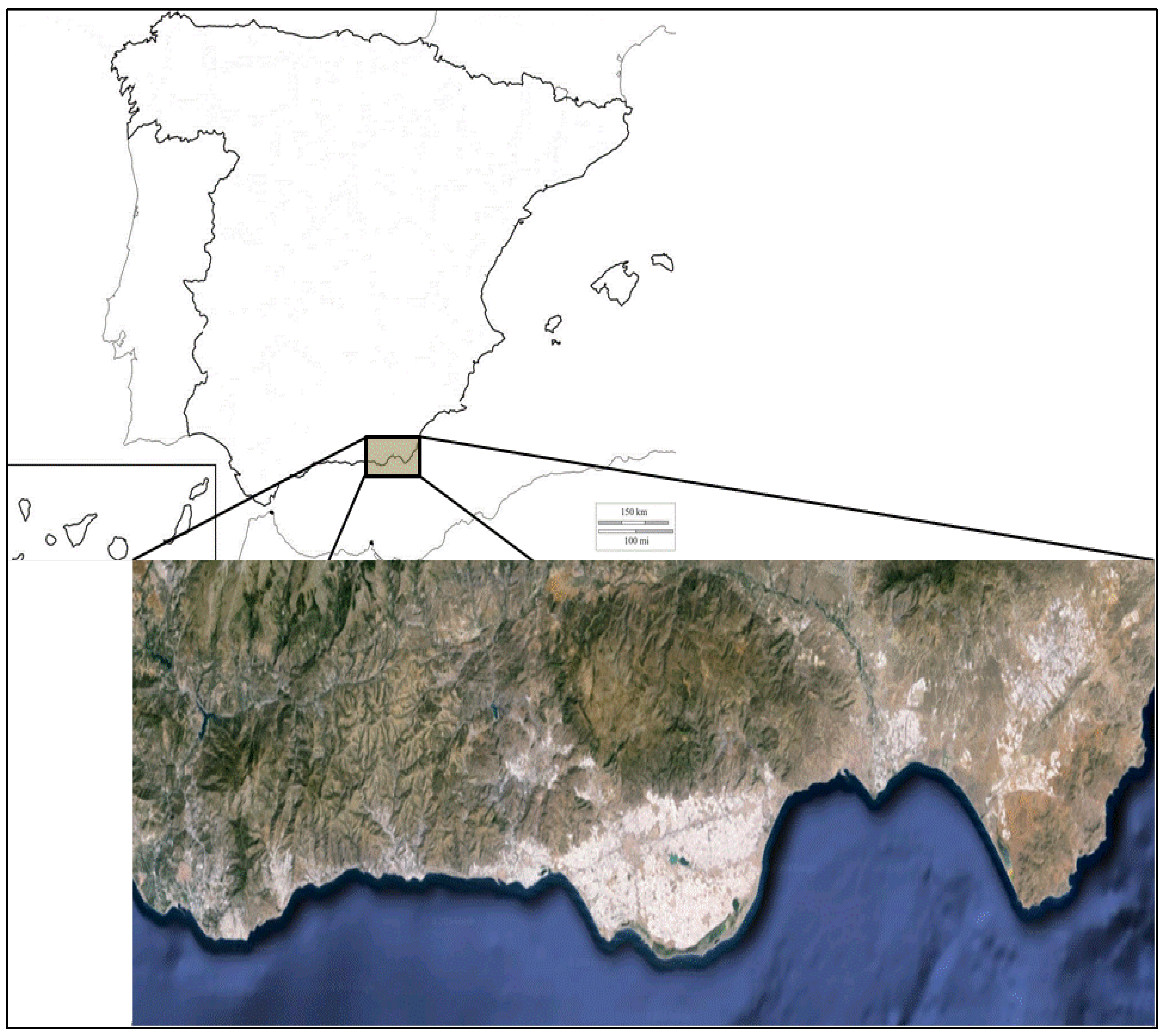
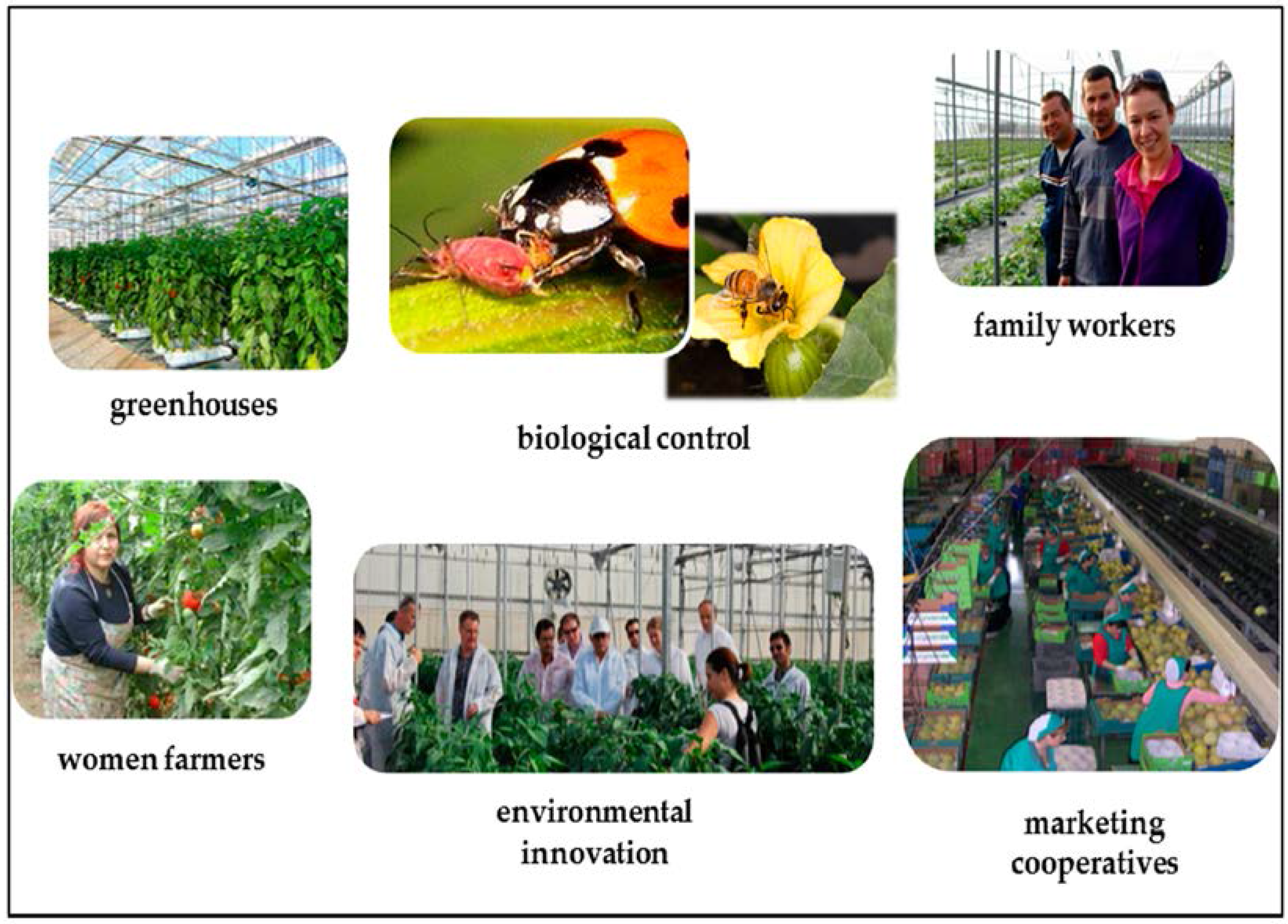

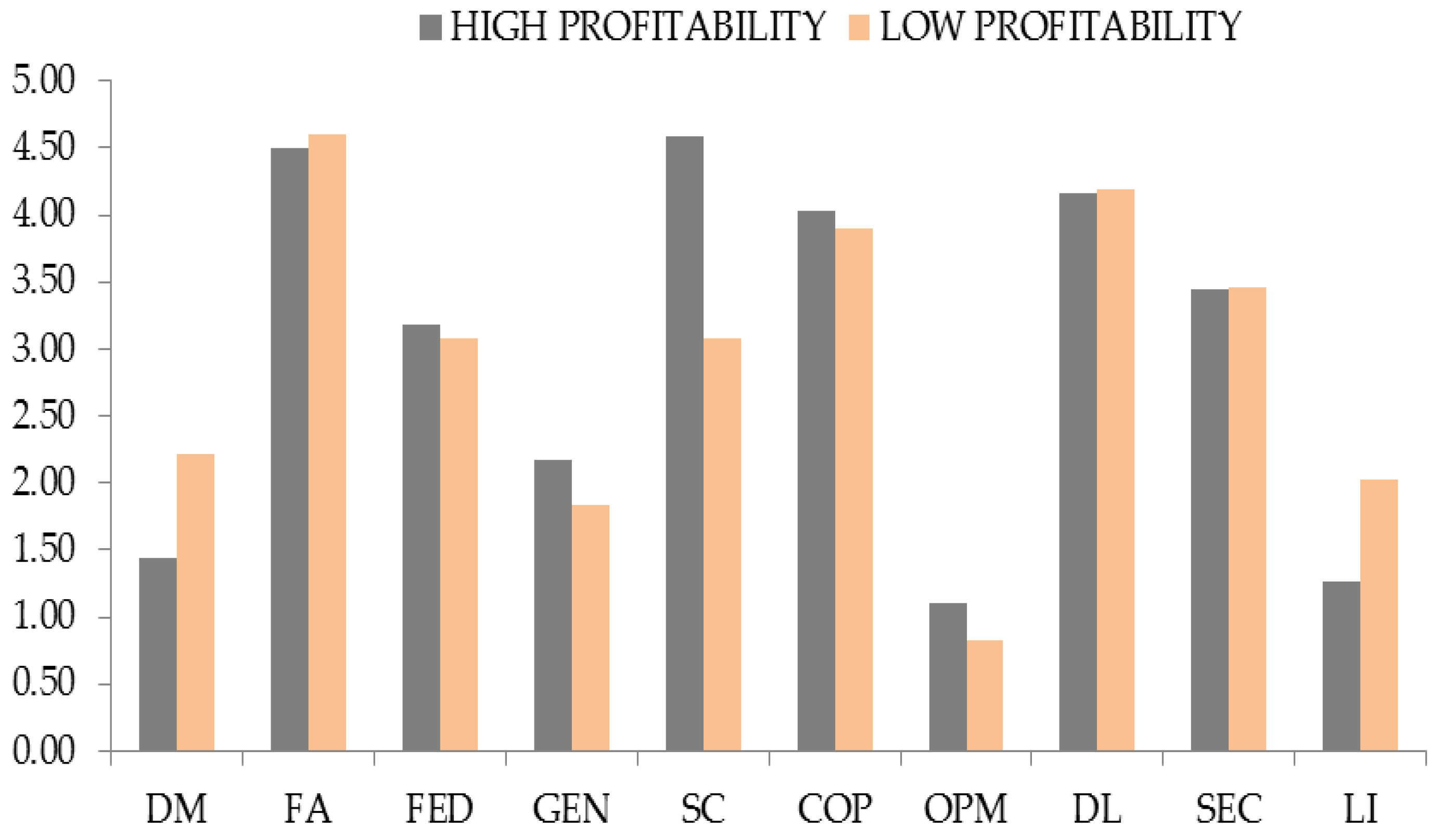
| Sustainability Dimensions | Variables | Description |
|---|---|---|
| Socio-economic variables | DM (Decision-Markers) | Number of family farm decision-makers. |
| FA (Farm decision-markers´ Age) | Family farm decision-makers’ age. | |
| FED (Farm decision-markers´ Education) | Family farm decision-makers’ level of education. Measured on a scale of 1 (no education), 2 (primary education), 3 (middle school), 4 (high school or vocational training), or 5 (university or higher education). | |
| GEN (Generation) | Number of generations that have run the family farm. This is indicative of the farm’s age. | |
| SC (Scale) | Number of hectares cultivated by the family farm, as an indication of the farm’s size. | |
| SP (Specialization) | Level of specialization, i.e., number of crops cultivated by the family farm. Thus the lower this variable is, the higher the family farm’s specialization. | |
| COP (Cooperatives) | Cooperatives efficiency, i.e., the family farm’s valuation of the efficiency of the marketing cooperatives in the sector. | |
| Environmental-innovation variables | OPM (Organic Production Management) | Organic production and/or integrated pest management (in kilograms) per hectare of total cultivated area. A weighted mean of all the crops was calculated. |
| EC (Environmental Certification) | Other environmental certifications not related to production. Dummy variable scored 0 (No) and 1 (Yes). | |
| DL (Daily Life) | How much the family farm tries to develop environmental-respectful practices in their daily life. Measured on a scale of 1 (not at all) to 5 (very much). | |
| SEC (Sector) | How family farm feels the influence from the sector to more aware about environmental sustainability. Measured on a scale of 1 (less) to 5 (more). | |
| EII (Environmental Innovation Investment) | It indicates whether the family farm invests in any agroecological improvement, innovation or new technology for reducing environmental impact. | |
| RD (Research and Development) | Family farm’s proactive work with research centers and universities on new environmental-respectful cultivation techniques and structural innovations in the farm to improve their competitiveness, scored from 1–5. | |
| LI (Labor intensity) | Average number of workers per cultivated area (hired and family workers). Thus the lower this variable is, the higher the family farm’s use of technology. |
| Variable | Mean | Std. Dev. | Min | Max |
|---|---|---|---|---|
| PROFIT 2 | 34,180.42 | 43,553.18 | −5000.99 | 243,909.20 |
| DM | 1.96 | 0.94 | 1 | 4 |
| FA | 45.67 | 10.14 | 22 | 66 |
| FED | 3.11 | 0.99 | 1 | 5 |
| GEN | 1.94 | 0.75 | 1 | 4 |
| SC | 3.01 | 3.21 | 0.4 | 20 |
| SP | 1.76 | 0.84 | 1 | 4 |
| COP | 3.94 | 0.75 | 1 | 5 |
| OPM 3 | 89,458 | 27,300.4 | 17,308.4 | 156,586.5 |
| EC | 0.22 | 0.42 | 0 | 1 |
| DL | 4.18 | 0.96 | 1 | 5 |
| SEC | 3.45 | 1.45 | 1 | 5 |
| EII 2 | 3651.28 | 4217.06 | 1240 | 9150 |
| RD | 3.54 | 0.89 | 1 | 5 |
| LI | 1.77 | 1.1 | 0.57 | 6.5 |
| Explanatory Variables | Step 1 | Step 2 |
|---|---|---|
| Constant | 30,005.65 | −28,587.27 |
| (0.8) | (−0.69) | |
| DM | −17,372.82 ** | −18,026.06 *** |
| (−2.69) | (−3.51) | |
| FA | −108.09 | −1155.32 * |
| (−0.17) | (−1.74) | |
| FED | 2409.39 * | 5060.31 * |
| (1.74) | (1.79) | |
| GEN | 2407.08 | −10,913.85 * |
| (0.5) | (−1.77) | |
| SC | 7114.65 * | 5697.09 * |
| (1.72) | (1.75) | |
| SP | −12,416.13 * | −6158.12 |
| (−1.73) | (−1.27) | |
| COP | 6982.89 | 11,485.37 * |
| (1.16) | (1.89) | |
| OPM | 0.53 *** | |
| (3.95) | ||
| EC | 21,748.94 | |
| (1.62) | ||
| DL | 14,327.50 ** | |
| (2.26) | ||
| SEC | −7819.90 ** | |
| (−2.23) | ||
| EII | 6766.55 * | |
| (1.82) | ||
| RD | 7090.29 | |
| (1.61) | ||
| LI | −7982.28 * | |
| (−1.99) | ||
| R2 | 0.40 | 0.65 |
| ΔR2 | 0.25 | |
| F-test | 2.40 * | 3.60 ** |
© 2016 by the authors; licensee MDPI, Basel, Switzerland. This article is an open access article distributed under the terms and conditions of the Creative Commons Attribution (CC-BY) license (http://creativecommons.org/licenses/by/4.0/).
Share and Cite
Piedra-Muñoz, L.; Galdeano-Gómez, E.; Pérez-Mesa, J.C. Is Sustainability Compatible with Profitability? An Empirical Analysis on Family Farming Activity. Sustainability 2016, 8, 893. https://doi.org/10.3390/su8090893
Piedra-Muñoz L, Galdeano-Gómez E, Pérez-Mesa JC. Is Sustainability Compatible with Profitability? An Empirical Analysis on Family Farming Activity. Sustainability. 2016; 8(9):893. https://doi.org/10.3390/su8090893
Chicago/Turabian StylePiedra-Muñoz, Laura, Emilio Galdeano-Gómez, and Juan C. Pérez-Mesa. 2016. "Is Sustainability Compatible with Profitability? An Empirical Analysis on Family Farming Activity" Sustainability 8, no. 9: 893. https://doi.org/10.3390/su8090893
APA StylePiedra-Muñoz, L., Galdeano-Gómez, E., & Pérez-Mesa, J. C. (2016). Is Sustainability Compatible with Profitability? An Empirical Analysis on Family Farming Activity. Sustainability, 8(9), 893. https://doi.org/10.3390/su8090893








